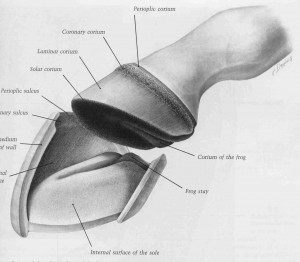WHY BAREFOOT?
Hi Everyone!
Our theme for the next month or so is going to be dealing with Why we should keep our horses Barefoot as well as Why, How & When to Boot your horse.
We’ll start with…
WHY BAREFOOT?
Horses have 5 Hearts…one in the Chest…and one on EACH FOOT!
Each hoof has a huge blood supply. This blood supply is a dense collection of vessels much like a thick spider web or sponge.
In other species, the blood flows back up the limbs aided by muscle contractions that “squeeze” the blood back up the leg.
Horses do not have muscles in their lower limbs. Therefore they rely heavily on “Hoof Mechanism” to return blood up the limb. Simplistically, as they take each step the hoof expands drawing blood into the hoof. As the foot comes off the ground, the hoof contracts and pushes blood back up the leg.
With each step the feet are “pumping” blood up the legs. This is why we say the horse has FIVE hearts!
This is a simplified explanation of hoof mechanism, but gives a good idea about how it works.
In order for a horse to have normal blood flow to the limbs, feet and the rest of the body it must have a working hoof mechanism and the ability to move.
As you can see, many things could interfere with this hoof mechanism. Horses are grazing animals and are designed to walk and eat nearly 24 hours a day. They take brief rest periods where they sleep (usually 15-20 minutes at a time). Confining a horse to a stall where it cannot walk will greatly inhibit the normal blood flow in a horse.
Improperly nailing a rigid shoe to the hooves will also inhibit the hoof mechanism. There are a variety of techniques for shoeing horses that can minimize this restriction, but no shoe will allow the mechanism to work as it would without the shoe.
Though hoof mechanism is important, we do NOT recommend or practice the trimming techniques that rapidly increase hoof mechanism. Rather, the best trimming techniques make changes slowly and result in a stable athletic foot which will eventually have good hoof mechanism without specifically “trimming” for it.
You CAN take a sound shod horse to barefoot without making it lame.
If a barefoot trimmer tells you your horse “has to be sore” to go barefoot – ask them to leave and find a good farrier!



